Case Study: Analyzing and Managing CVAD Infection in Patient Jim Karas
VerifiedAdded on 2023/04/21
|9
|2813
|306
Case Study
AI Summary
This case study examines the case of Jim Karas, who was admitted to the hospital with hypotension, delirium, infection, breathing difficulty, and agitation, stemming from a CVAD infection related to a central venous catheter insertion. The study elaborates on the intrinsic and extrinsic factors contributing to the infection, emphasizing the importance of adhering to guidelines from the Centre for Disease Control and Prevention, such as hub and port scrubbing with antiseptics, sterile equipment usage, and hand hygiene. It further discusses the prevention of local skin irritation through antimicrobial catheters and proper skin disinfection techniques, as well as the prevention and management of vascular occlusion by following catheter patency guidelines, using thrombolytic agents, and involving the patient's family in clinical decision-making. The study concludes that implementing evidence-based strategies is crucial for averting and treating CVAD-related complications, advocating for healthcare professionals to prioritize these interventions for effective patient management. Desklib offers a wide range of solved assignments and study resources for students.

Running head: CASE STUDY
Jim Karas Case Study
Name of the Student
Name of the University
Author Note
Jim Karas Case Study
Name of the Student
Name of the University
Author Note
Paraphrase This Document
Need a fresh take? Get an instant paraphrase of this document with our AI Paraphraser
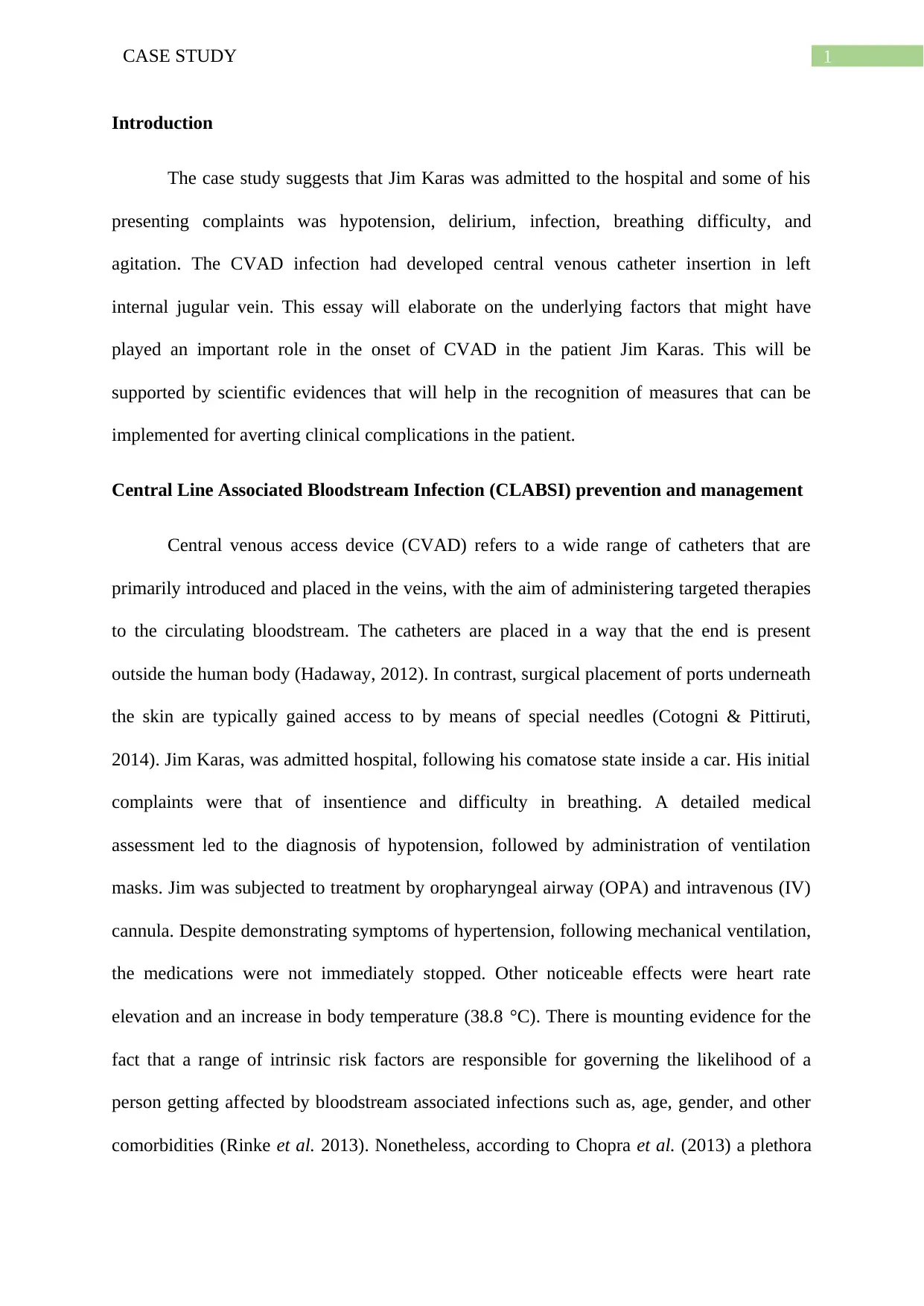
1CASE STUDY
Introduction
The case study suggests that Jim Karas was admitted to the hospital and some of his
presenting complaints was hypotension, delirium, infection, breathing difficulty, and
agitation. The CVAD infection had developed central venous catheter insertion in left
internal jugular vein. This essay will elaborate on the underlying factors that might have
played an important role in the onset of CVAD in the patient Jim Karas. This will be
supported by scientific evidences that will help in the recognition of measures that can be
implemented for averting clinical complications in the patient.
Central Line Associated Bloodstream Infection (CLABSI) prevention and management
Central venous access device (CVAD) refers to a wide range of catheters that are
primarily introduced and placed in the veins, with the aim of administering targeted therapies
to the circulating bloodstream. The catheters are placed in a way that the end is present
outside the human body (Hadaway, 2012). In contrast, surgical placement of ports underneath
the skin are typically gained access to by means of special needles (Cotogni & Pittiruti,
2014). Jim Karas, was admitted hospital, following his comatose state inside a car. His initial
complaints were that of insentience and difficulty in breathing. A detailed medical
assessment led to the diagnosis of hypotension, followed by administration of ventilation
masks. Jim was subjected to treatment by oropharyngeal airway (OPA) and intravenous (IV)
cannula. Despite demonstrating symptoms of hypertension, following mechanical ventilation,
the medications were not immediately stopped. Other noticeable effects were heart rate
elevation and an increase in body temperature (38.8 °C). There is mounting evidence for the
fact that a range of intrinsic risk factors are responsible for governing the likelihood of a
person getting affected by bloodstream associated infections such as, age, gender, and other
comorbidities (Rinke et al. 2013). Nonetheless, according to Chopra et al. (2013) a plethora
Introduction
The case study suggests that Jim Karas was admitted to the hospital and some of his
presenting complaints was hypotension, delirium, infection, breathing difficulty, and
agitation. The CVAD infection had developed central venous catheter insertion in left
internal jugular vein. This essay will elaborate on the underlying factors that might have
played an important role in the onset of CVAD in the patient Jim Karas. This will be
supported by scientific evidences that will help in the recognition of measures that can be
implemented for averting clinical complications in the patient.
Central Line Associated Bloodstream Infection (CLABSI) prevention and management
Central venous access device (CVAD) refers to a wide range of catheters that are
primarily introduced and placed in the veins, with the aim of administering targeted therapies
to the circulating bloodstream. The catheters are placed in a way that the end is present
outside the human body (Hadaway, 2012). In contrast, surgical placement of ports underneath
the skin are typically gained access to by means of special needles (Cotogni & Pittiruti,
2014). Jim Karas, was admitted hospital, following his comatose state inside a car. His initial
complaints were that of insentience and difficulty in breathing. A detailed medical
assessment led to the diagnosis of hypotension, followed by administration of ventilation
masks. Jim was subjected to treatment by oropharyngeal airway (OPA) and intravenous (IV)
cannula. Despite demonstrating symptoms of hypertension, following mechanical ventilation,
the medications were not immediately stopped. Other noticeable effects were heart rate
elevation and an increase in body temperature (38.8 °C). There is mounting evidence for the
fact that a range of intrinsic risk factors are responsible for governing the likelihood of a
person getting affected by bloodstream associated infections such as, age, gender, and other
comorbidities (Rinke et al. 2013). Nonetheless, according to Chopra et al. (2013) a plethora
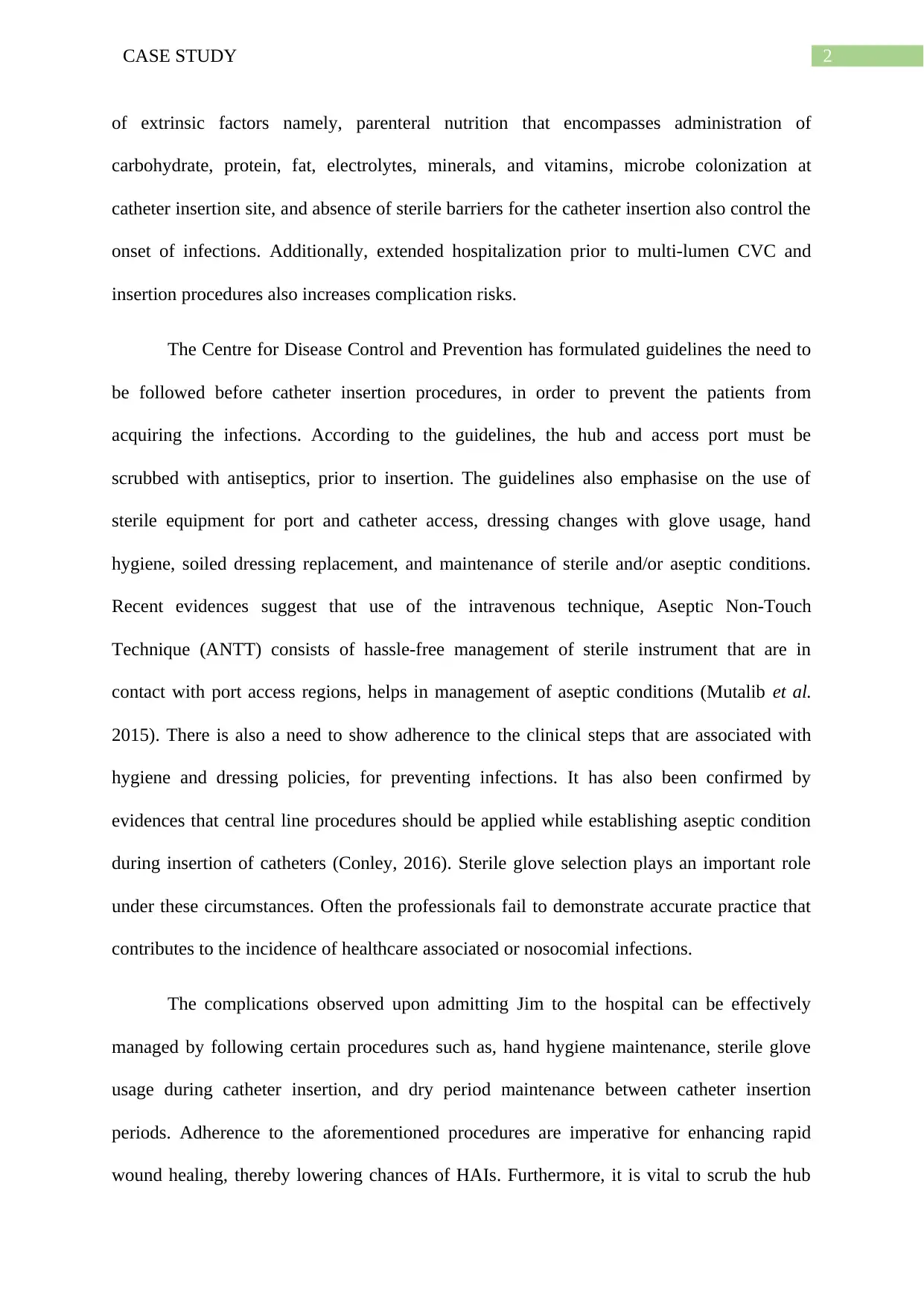
2CASE STUDY
of extrinsic factors namely, parenteral nutrition that encompasses administration of
carbohydrate, protein, fat, electrolytes, minerals, and vitamins, microbe colonization at
catheter insertion site, and absence of sterile barriers for the catheter insertion also control the
onset of infections. Additionally, extended hospitalization prior to multi-lumen CVC and
insertion procedures also increases complication risks.
The Centre for Disease Control and Prevention has formulated guidelines the need to
be followed before catheter insertion procedures, in order to prevent the patients from
acquiring the infections. According to the guidelines, the hub and access port must be
scrubbed with antiseptics, prior to insertion. The guidelines also emphasise on the use of
sterile equipment for port and catheter access, dressing changes with glove usage, hand
hygiene, soiled dressing replacement, and maintenance of sterile and/or aseptic conditions.
Recent evidences suggest that use of the intravenous technique, Aseptic Non-Touch
Technique (ANTT) consists of hassle-free management of sterile instrument that are in
contact with port access regions, helps in management of aseptic conditions (Mutalib et al.
2015). There is also a need to show adherence to the clinical steps that are associated with
hygiene and dressing policies, for preventing infections. It has also been confirmed by
evidences that central line procedures should be applied while establishing aseptic condition
during insertion of catheters (Conley, 2016). Sterile glove selection plays an important role
under these circumstances. Often the professionals fail to demonstrate accurate practice that
contributes to the incidence of healthcare associated or nosocomial infections.
The complications observed upon admitting Jim to the hospital can be effectively
managed by following certain procedures such as, hand hygiene maintenance, sterile glove
usage during catheter insertion, and dry period maintenance between catheter insertion
periods. Adherence to the aforementioned procedures are imperative for enhancing rapid
wound healing, thereby lowering chances of HAIs. Furthermore, it is vital to scrub the hub
of extrinsic factors namely, parenteral nutrition that encompasses administration of
carbohydrate, protein, fat, electrolytes, minerals, and vitamins, microbe colonization at
catheter insertion site, and absence of sterile barriers for the catheter insertion also control the
onset of infections. Additionally, extended hospitalization prior to multi-lumen CVC and
insertion procedures also increases complication risks.
The Centre for Disease Control and Prevention has formulated guidelines the need to
be followed before catheter insertion procedures, in order to prevent the patients from
acquiring the infections. According to the guidelines, the hub and access port must be
scrubbed with antiseptics, prior to insertion. The guidelines also emphasise on the use of
sterile equipment for port and catheter access, dressing changes with glove usage, hand
hygiene, soiled dressing replacement, and maintenance of sterile and/or aseptic conditions.
Recent evidences suggest that use of the intravenous technique, Aseptic Non-Touch
Technique (ANTT) consists of hassle-free management of sterile instrument that are in
contact with port access regions, helps in management of aseptic conditions (Mutalib et al.
2015). There is also a need to show adherence to the clinical steps that are associated with
hygiene and dressing policies, for preventing infections. It has also been confirmed by
evidences that central line procedures should be applied while establishing aseptic condition
during insertion of catheters (Conley, 2016). Sterile glove selection plays an important role
under these circumstances. Often the professionals fail to demonstrate accurate practice that
contributes to the incidence of healthcare associated or nosocomial infections.
The complications observed upon admitting Jim to the hospital can be effectively
managed by following certain procedures such as, hand hygiene maintenance, sterile glove
usage during catheter insertion, and dry period maintenance between catheter insertion
periods. Adherence to the aforementioned procedures are imperative for enhancing rapid
wound healing, thereby lowering chances of HAIs. Furthermore, it is vital to scrub the hub
⊘ This is a preview!⊘
Do you want full access?
Subscribe today to unlock all pages.

Trusted by 1+ million students worldwide
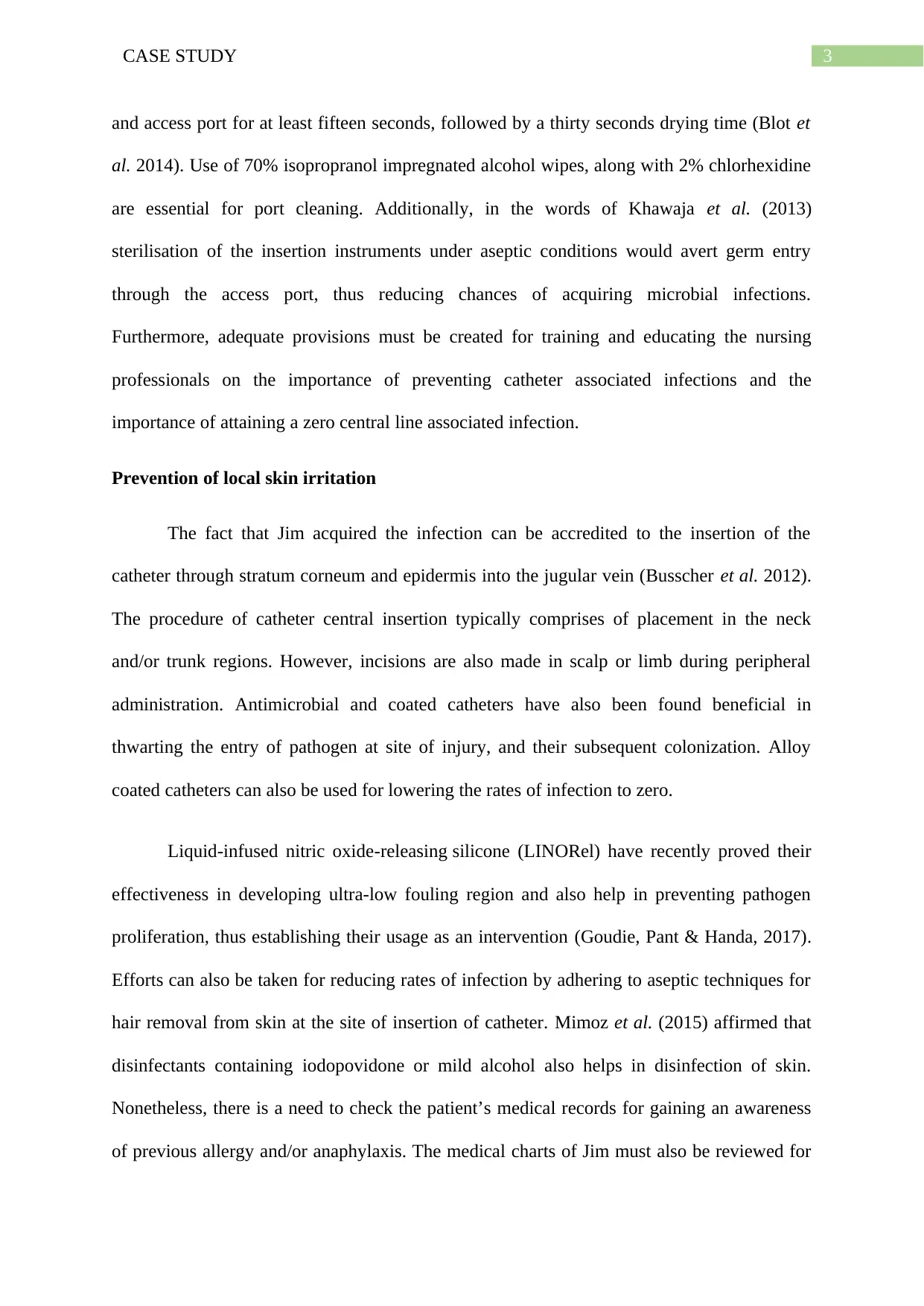
3CASE STUDY
and access port for at least fifteen seconds, followed by a thirty seconds drying time (Blot et
al. 2014). Use of 70% isopropranol impregnated alcohol wipes, along with 2% chlorhexidine
are essential for port cleaning. Additionally, in the words of Khawaja et al. (2013)
sterilisation of the insertion instruments under aseptic conditions would avert germ entry
through the access port, thus reducing chances of acquiring microbial infections.
Furthermore, adequate provisions must be created for training and educating the nursing
professionals on the importance of preventing catheter associated infections and the
importance of attaining a zero central line associated infection.
Prevention of local skin irritation
The fact that Jim acquired the infection can be accredited to the insertion of the
catheter through stratum corneum and epidermis into the jugular vein (Busscher et al. 2012).
The procedure of catheter central insertion typically comprises of placement in the neck
and/or trunk regions. However, incisions are also made in scalp or limb during peripheral
administration. Antimicrobial and coated catheters have also been found beneficial in
thwarting the entry of pathogen at site of injury, and their subsequent colonization. Alloy
coated catheters can also be used for lowering the rates of infection to zero.
Liquid-infused nitric oxide-releasing silicone (LINORel) have recently proved their
effectiveness in developing ultra-low fouling region and also help in preventing pathogen
proliferation, thus establishing their usage as an intervention (Goudie, Pant & Handa, 2017).
Efforts can also be taken for reducing rates of infection by adhering to aseptic techniques for
hair removal from skin at the site of insertion of catheter. Mimoz et al. (2015) affirmed that
disinfectants containing iodopovidone or mild alcohol also helps in disinfection of skin.
Nonetheless, there is a need to check the patient’s medical records for gaining an awareness
of previous allergy and/or anaphylaxis. The medical charts of Jim must also be reviewed for
and access port for at least fifteen seconds, followed by a thirty seconds drying time (Blot et
al. 2014). Use of 70% isopropranol impregnated alcohol wipes, along with 2% chlorhexidine
are essential for port cleaning. Additionally, in the words of Khawaja et al. (2013)
sterilisation of the insertion instruments under aseptic conditions would avert germ entry
through the access port, thus reducing chances of acquiring microbial infections.
Furthermore, adequate provisions must be created for training and educating the nursing
professionals on the importance of preventing catheter associated infections and the
importance of attaining a zero central line associated infection.
Prevention of local skin irritation
The fact that Jim acquired the infection can be accredited to the insertion of the
catheter through stratum corneum and epidermis into the jugular vein (Busscher et al. 2012).
The procedure of catheter central insertion typically comprises of placement in the neck
and/or trunk regions. However, incisions are also made in scalp or limb during peripheral
administration. Antimicrobial and coated catheters have also been found beneficial in
thwarting the entry of pathogen at site of injury, and their subsequent colonization. Alloy
coated catheters can also be used for lowering the rates of infection to zero.
Liquid-infused nitric oxide-releasing silicone (LINORel) have recently proved their
effectiveness in developing ultra-low fouling region and also help in preventing pathogen
proliferation, thus establishing their usage as an intervention (Goudie, Pant & Handa, 2017).
Efforts can also be taken for reducing rates of infection by adhering to aseptic techniques for
hair removal from skin at the site of insertion of catheter. Mimoz et al. (2015) affirmed that
disinfectants containing iodopovidone or mild alcohol also helps in disinfection of skin.
Nonetheless, there is a need to check the patient’s medical records for gaining an awareness
of previous allergy and/or anaphylaxis. The medical charts of Jim must also be reviewed for
Paraphrase This Document
Need a fresh take? Get an instant paraphrase of this document with our AI Paraphraser
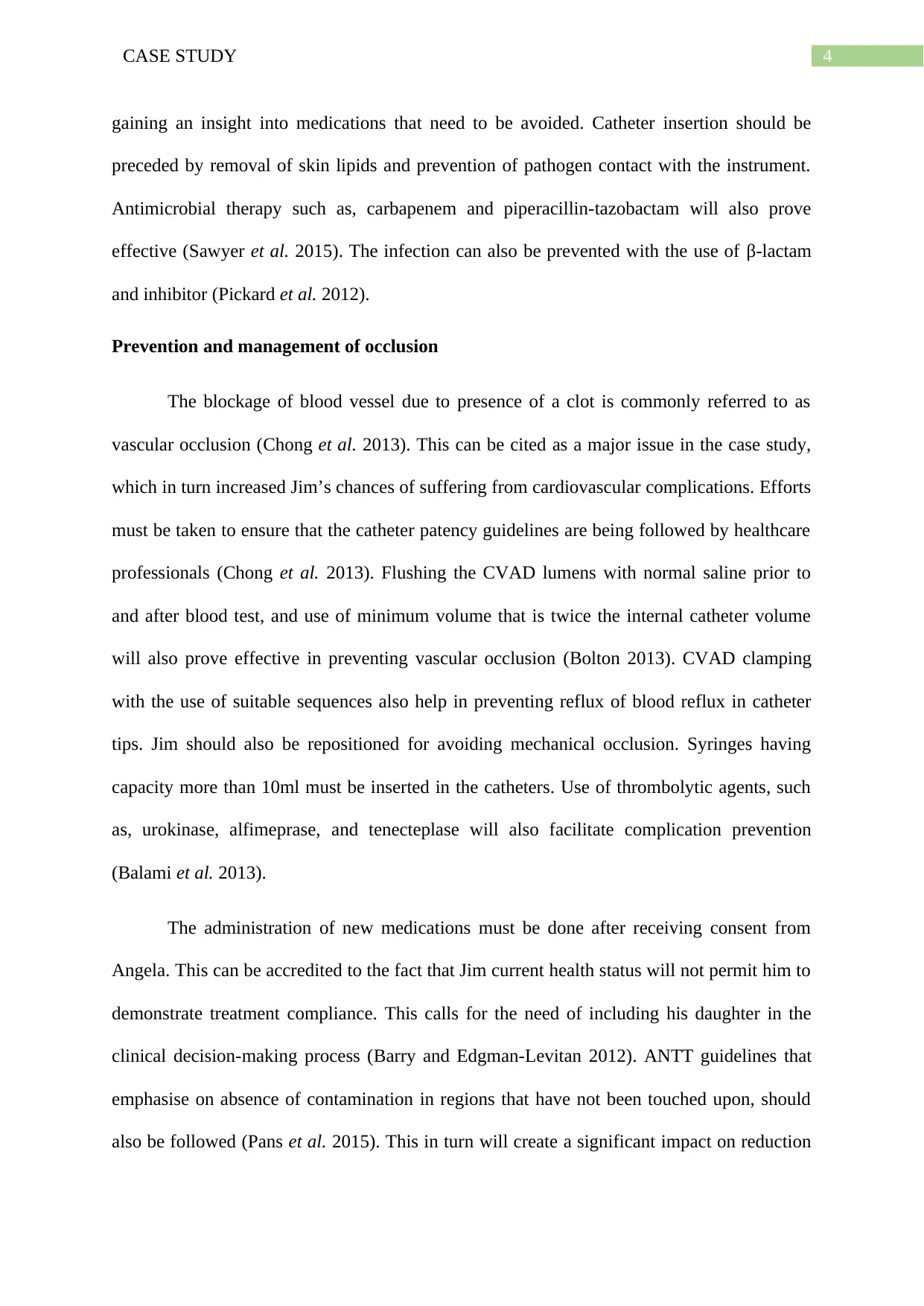
4CASE STUDY
gaining an insight into medications that need to be avoided. Catheter insertion should be
preceded by removal of skin lipids and prevention of pathogen contact with the instrument.
Antimicrobial therapy such as, carbapenem and piperacillin-tazobactam will also prove
effective (Sawyer et al. 2015). The infection can also be prevented with the use of β-lactam
and inhibitor (Pickard et al. 2012).
Prevention and management of occlusion
The blockage of blood vessel due to presence of a clot is commonly referred to as
vascular occlusion (Chong et al. 2013). This can be cited as a major issue in the case study,
which in turn increased Jim’s chances of suffering from cardiovascular complications. Efforts
must be taken to ensure that the catheter patency guidelines are being followed by healthcare
professionals (Chong et al. 2013). Flushing the CVAD lumens with normal saline prior to
and after blood test, and use of minimum volume that is twice the internal catheter volume
will also prove effective in preventing vascular occlusion (Bolton 2013). CVAD clamping
with the use of suitable sequences also help in preventing reflux of blood reflux in catheter
tips. Jim should also be repositioned for avoiding mechanical occlusion. Syringes having
capacity more than 10ml must be inserted in the catheters. Use of thrombolytic agents, such
as, urokinase, alfimeprase, and tenecteplase will also facilitate complication prevention
(Balami et al. 2013).
The administration of new medications must be done after receiving consent from
Angela. This can be accredited to the fact that Jim current health status will not permit him to
demonstrate treatment compliance. This calls for the need of including his daughter in the
clinical decision-making process (Barry and Edgman-Levitan 2012). ANTT guidelines that
emphasise on absence of contamination in regions that have not been touched upon, should
also be followed (Pans et al. 2015). This in turn will create a significant impact on reduction
gaining an insight into medications that need to be avoided. Catheter insertion should be
preceded by removal of skin lipids and prevention of pathogen contact with the instrument.
Antimicrobial therapy such as, carbapenem and piperacillin-tazobactam will also prove
effective (Sawyer et al. 2015). The infection can also be prevented with the use of β-lactam
and inhibitor (Pickard et al. 2012).
Prevention and management of occlusion
The blockage of blood vessel due to presence of a clot is commonly referred to as
vascular occlusion (Chong et al. 2013). This can be cited as a major issue in the case study,
which in turn increased Jim’s chances of suffering from cardiovascular complications. Efforts
must be taken to ensure that the catheter patency guidelines are being followed by healthcare
professionals (Chong et al. 2013). Flushing the CVAD lumens with normal saline prior to
and after blood test, and use of minimum volume that is twice the internal catheter volume
will also prove effective in preventing vascular occlusion (Bolton 2013). CVAD clamping
with the use of suitable sequences also help in preventing reflux of blood reflux in catheter
tips. Jim should also be repositioned for avoiding mechanical occlusion. Syringes having
capacity more than 10ml must be inserted in the catheters. Use of thrombolytic agents, such
as, urokinase, alfimeprase, and tenecteplase will also facilitate complication prevention
(Balami et al. 2013).
The administration of new medications must be done after receiving consent from
Angela. This can be accredited to the fact that Jim current health status will not permit him to
demonstrate treatment compliance. This calls for the need of including his daughter in the
clinical decision-making process (Barry and Edgman-Levitan 2012). ANTT guidelines that
emphasise on absence of contamination in regions that have not been touched upon, should
also be followed (Pans et al. 2015). This in turn will create a significant impact on reduction
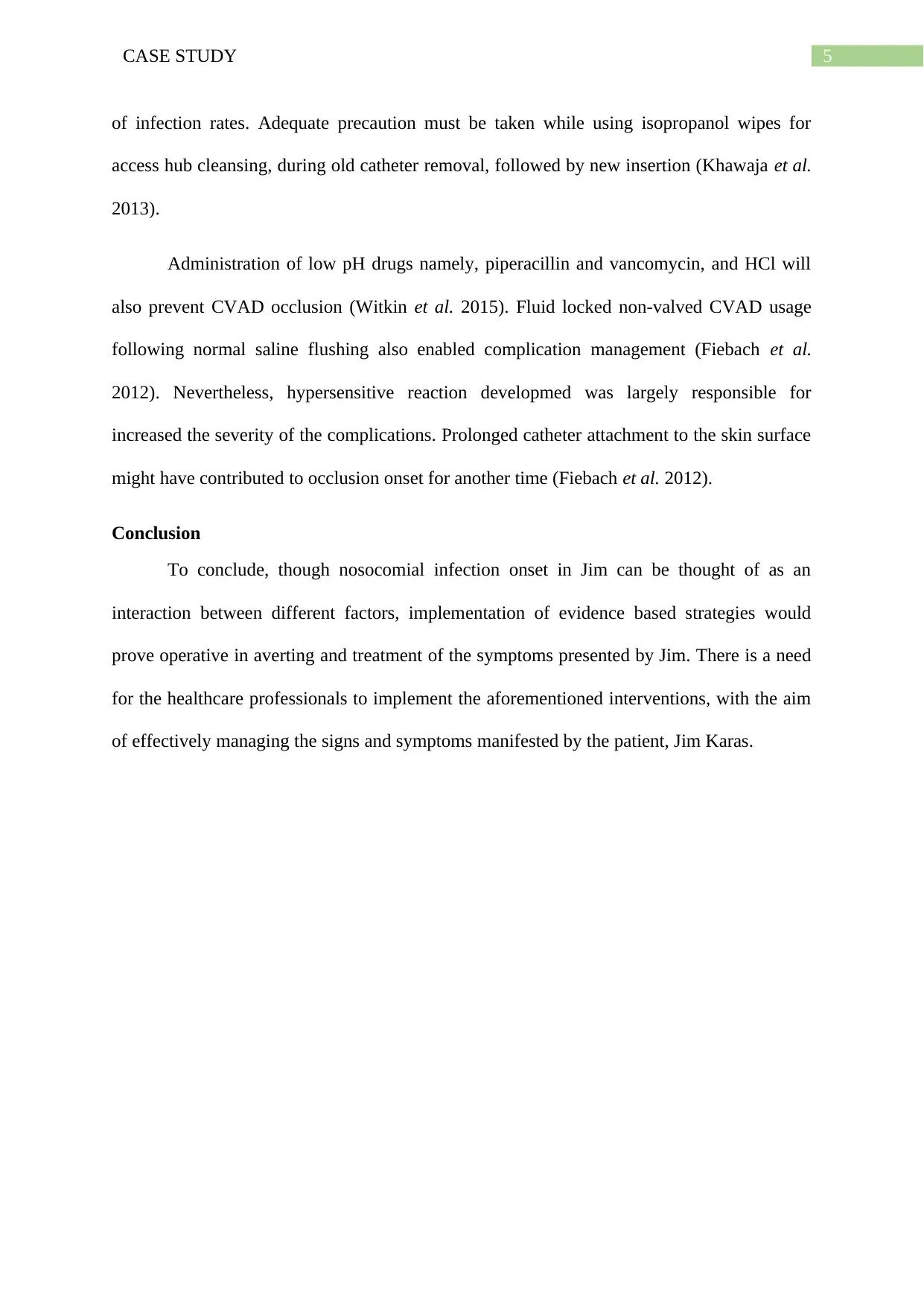
5CASE STUDY
of infection rates. Adequate precaution must be taken while using isopropanol wipes for
access hub cleansing, during old catheter removal, followed by new insertion (Khawaja et al.
2013).
Administration of low pH drugs namely, piperacillin and vancomycin, and HCl will
also prevent CVAD occlusion (Witkin et al. 2015). Fluid locked non-valved CVAD usage
following normal saline flushing also enabled complication management (Fiebach et al.
2012). Nevertheless, hypersensitive reaction developmed was largely responsible for
increased the severity of the complications. Prolonged catheter attachment to the skin surface
might have contributed to occlusion onset for another time (Fiebach et al. 2012).
Conclusion
To conclude, though nosocomial infection onset in Jim can be thought of as an
interaction between different factors, implementation of evidence based strategies would
prove operative in averting and treatment of the symptoms presented by Jim. There is a need
for the healthcare professionals to implement the aforementioned interventions, with the aim
of effectively managing the signs and symptoms manifested by the patient, Jim Karas.
of infection rates. Adequate precaution must be taken while using isopropanol wipes for
access hub cleansing, during old catheter removal, followed by new insertion (Khawaja et al.
2013).
Administration of low pH drugs namely, piperacillin and vancomycin, and HCl will
also prevent CVAD occlusion (Witkin et al. 2015). Fluid locked non-valved CVAD usage
following normal saline flushing also enabled complication management (Fiebach et al.
2012). Nevertheless, hypersensitive reaction developmed was largely responsible for
increased the severity of the complications. Prolonged catheter attachment to the skin surface
might have contributed to occlusion onset for another time (Fiebach et al. 2012).
Conclusion
To conclude, though nosocomial infection onset in Jim can be thought of as an
interaction between different factors, implementation of evidence based strategies would
prove operative in averting and treatment of the symptoms presented by Jim. There is a need
for the healthcare professionals to implement the aforementioned interventions, with the aim
of effectively managing the signs and symptoms manifested by the patient, Jim Karas.
⊘ This is a preview!⊘
Do you want full access?
Subscribe today to unlock all pages.

Trusted by 1+ million students worldwide
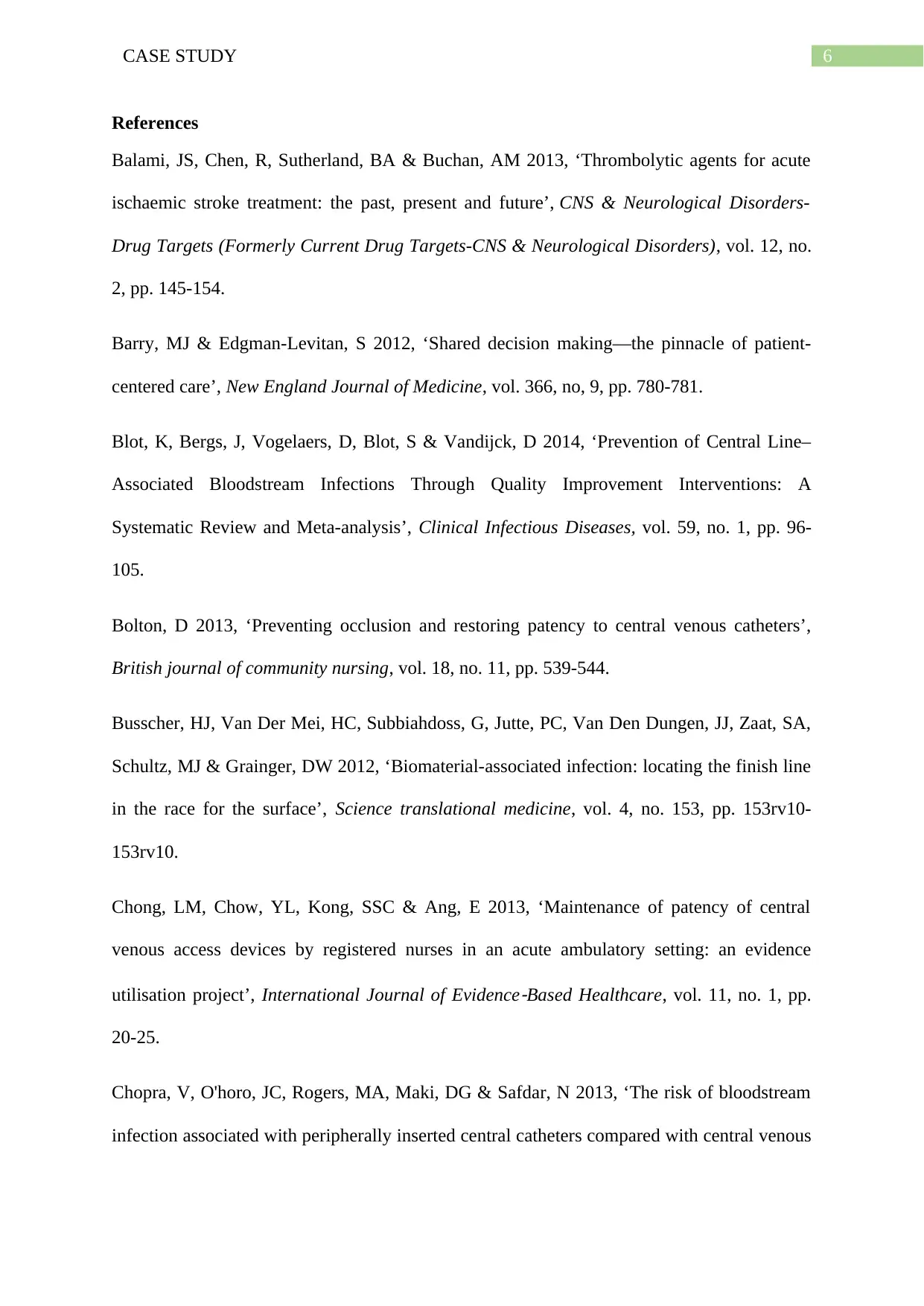
6CASE STUDY
References
Balami, JS, Chen, R, Sutherland, BA & Buchan, AM 2013, ‘Thrombolytic agents for acute
ischaemic stroke treatment: the past, present and future’, CNS & Neurological Disorders-
Drug Targets (Formerly Current Drug Targets-CNS & Neurological Disorders), vol. 12, no.
2, pp. 145-154.
Barry, MJ & Edgman-Levitan, S 2012, ‘Shared decision making—the pinnacle of patient-
centered care’, New England Journal of Medicine, vol. 366, no, 9, pp. 780-781.
Blot, K, Bergs, J, Vogelaers, D, Blot, S & Vandijck, D 2014, ‘Prevention of Central Line–
Associated Bloodstream Infections Through Quality Improvement Interventions: A
Systematic Review and Meta-analysis’, Clinical Infectious Diseases, vol. 59, no. 1, pp. 96-
105.
Bolton, D 2013, ‘Preventing occlusion and restoring patency to central venous catheters’,
British journal of community nursing, vol. 18, no. 11, pp. 539-544.
Busscher, HJ, Van Der Mei, HC, Subbiahdoss, G, Jutte, PC, Van Den Dungen, JJ, Zaat, SA,
Schultz, MJ & Grainger, DW 2012, ‘Biomaterial-associated infection: locating the finish line
in the race for the surface’, Science translational medicine, vol. 4, no. 153, pp. 153rv10-
153rv10.
Chong, LM, Chow, YL, Kong, SSC & Ang, E 2013, ‘Maintenance of patency of central
venous access devices by registered nurses in an acute ambulatory setting: an evidence
utilisation project’, International Journal of Evidence
‐Based Healthcare, vol. 11, no. 1, pp.
20-25.
Chopra, V, O'horo, JC, Rogers, MA, Maki, DG & Safdar, N 2013, ‘The risk of bloodstream
infection associated with peripherally inserted central catheters compared with central venous
References
Balami, JS, Chen, R, Sutherland, BA & Buchan, AM 2013, ‘Thrombolytic agents for acute
ischaemic stroke treatment: the past, present and future’, CNS & Neurological Disorders-
Drug Targets (Formerly Current Drug Targets-CNS & Neurological Disorders), vol. 12, no.
2, pp. 145-154.
Barry, MJ & Edgman-Levitan, S 2012, ‘Shared decision making—the pinnacle of patient-
centered care’, New England Journal of Medicine, vol. 366, no, 9, pp. 780-781.
Blot, K, Bergs, J, Vogelaers, D, Blot, S & Vandijck, D 2014, ‘Prevention of Central Line–
Associated Bloodstream Infections Through Quality Improvement Interventions: A
Systematic Review and Meta-analysis’, Clinical Infectious Diseases, vol. 59, no. 1, pp. 96-
105.
Bolton, D 2013, ‘Preventing occlusion and restoring patency to central venous catheters’,
British journal of community nursing, vol. 18, no. 11, pp. 539-544.
Busscher, HJ, Van Der Mei, HC, Subbiahdoss, G, Jutte, PC, Van Den Dungen, JJ, Zaat, SA,
Schultz, MJ & Grainger, DW 2012, ‘Biomaterial-associated infection: locating the finish line
in the race for the surface’, Science translational medicine, vol. 4, no. 153, pp. 153rv10-
153rv10.
Chong, LM, Chow, YL, Kong, SSC & Ang, E 2013, ‘Maintenance of patency of central
venous access devices by registered nurses in an acute ambulatory setting: an evidence
utilisation project’, International Journal of Evidence
‐Based Healthcare, vol. 11, no. 1, pp.
20-25.
Chopra, V, O'horo, JC, Rogers, MA, Maki, DG & Safdar, N 2013, ‘The risk of bloodstream
infection associated with peripherally inserted central catheters compared with central venous
Paraphrase This Document
Need a fresh take? Get an instant paraphrase of this document with our AI Paraphraser
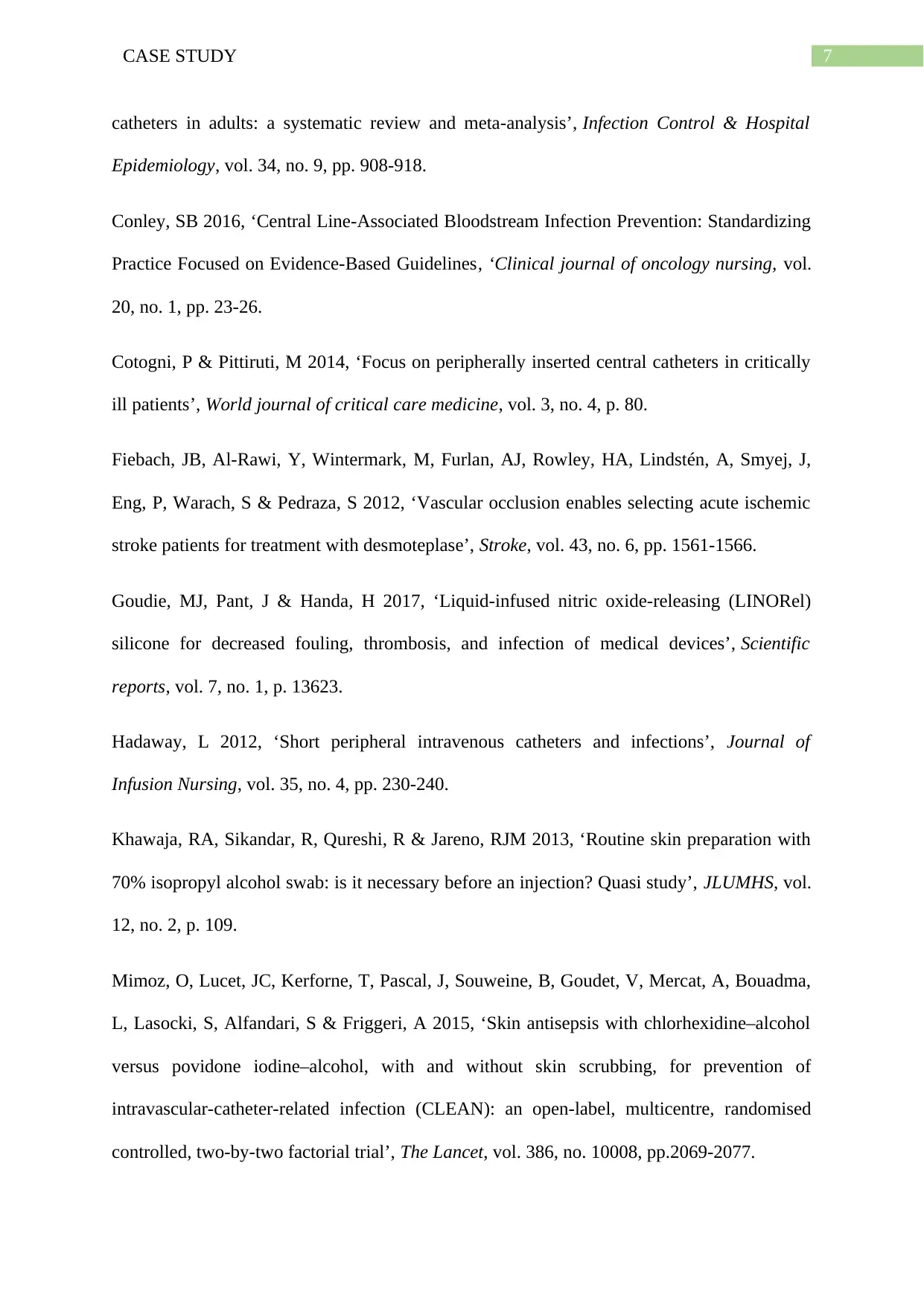
7CASE STUDY
catheters in adults: a systematic review and meta-analysis’, Infection Control & Hospital
Epidemiology, vol. 34, no. 9, pp. 908-918.
Conley, SB 2016, ‘Central Line-Associated Bloodstream Infection Prevention: Standardizing
Practice Focused on Evidence-Based Guidelines, ‘Clinical journal of oncology nursing, vol.
20, no. 1, pp. 23-26.
Cotogni, P & Pittiruti, M 2014, ‘Focus on peripherally inserted central catheters in critically
ill patients’, World journal of critical care medicine, vol. 3, no. 4, p. 80.
Fiebach, JB, Al-Rawi, Y, Wintermark, M, Furlan, AJ, Rowley, HA, Lindstén, A, Smyej, J,
Eng, P, Warach, S & Pedraza, S 2012, ‘Vascular occlusion enables selecting acute ischemic
stroke patients for treatment with desmoteplase’, Stroke, vol. 43, no. 6, pp. 1561-1566.
Goudie, MJ, Pant, J & Handa, H 2017, ‘Liquid-infused nitric oxide-releasing (LINORel)
silicone for decreased fouling, thrombosis, and infection of medical devices’, Scientific
reports, vol. 7, no. 1, p. 13623.
Hadaway, L 2012, ‘Short peripheral intravenous catheters and infections’, Journal of
Infusion Nursing, vol. 35, no. 4, pp. 230-240.
Khawaja, RA, Sikandar, R, Qureshi, R & Jareno, RJM 2013, ‘Routine skin preparation with
70% isopropyl alcohol swab: is it necessary before an injection? Quasi study’, JLUMHS, vol.
12, no. 2, p. 109.
Mimoz, O, Lucet, JC, Kerforne, T, Pascal, J, Souweine, B, Goudet, V, Mercat, A, Bouadma,
L, Lasocki, S, Alfandari, S & Friggeri, A 2015, ‘Skin antisepsis with chlorhexidine–alcohol
versus povidone iodine–alcohol, with and without skin scrubbing, for prevention of
intravascular-catheter-related infection (CLEAN): an open-label, multicentre, randomised
controlled, two-by-two factorial trial’, The Lancet, vol. 386, no. 10008, pp.2069-2077.
catheters in adults: a systematic review and meta-analysis’, Infection Control & Hospital
Epidemiology, vol. 34, no. 9, pp. 908-918.
Conley, SB 2016, ‘Central Line-Associated Bloodstream Infection Prevention: Standardizing
Practice Focused on Evidence-Based Guidelines, ‘Clinical journal of oncology nursing, vol.
20, no. 1, pp. 23-26.
Cotogni, P & Pittiruti, M 2014, ‘Focus on peripherally inserted central catheters in critically
ill patients’, World journal of critical care medicine, vol. 3, no. 4, p. 80.
Fiebach, JB, Al-Rawi, Y, Wintermark, M, Furlan, AJ, Rowley, HA, Lindstén, A, Smyej, J,
Eng, P, Warach, S & Pedraza, S 2012, ‘Vascular occlusion enables selecting acute ischemic
stroke patients for treatment with desmoteplase’, Stroke, vol. 43, no. 6, pp. 1561-1566.
Goudie, MJ, Pant, J & Handa, H 2017, ‘Liquid-infused nitric oxide-releasing (LINORel)
silicone for decreased fouling, thrombosis, and infection of medical devices’, Scientific
reports, vol. 7, no. 1, p. 13623.
Hadaway, L 2012, ‘Short peripheral intravenous catheters and infections’, Journal of
Infusion Nursing, vol. 35, no. 4, pp. 230-240.
Khawaja, RA, Sikandar, R, Qureshi, R & Jareno, RJM 2013, ‘Routine skin preparation with
70% isopropyl alcohol swab: is it necessary before an injection? Quasi study’, JLUMHS, vol.
12, no. 2, p. 109.
Mimoz, O, Lucet, JC, Kerforne, T, Pascal, J, Souweine, B, Goudet, V, Mercat, A, Bouadma,
L, Lasocki, S, Alfandari, S & Friggeri, A 2015, ‘Skin antisepsis with chlorhexidine–alcohol
versus povidone iodine–alcohol, with and without skin scrubbing, for prevention of
intravascular-catheter-related infection (CLEAN): an open-label, multicentre, randomised
controlled, two-by-two factorial trial’, The Lancet, vol. 386, no. 10008, pp.2069-2077.
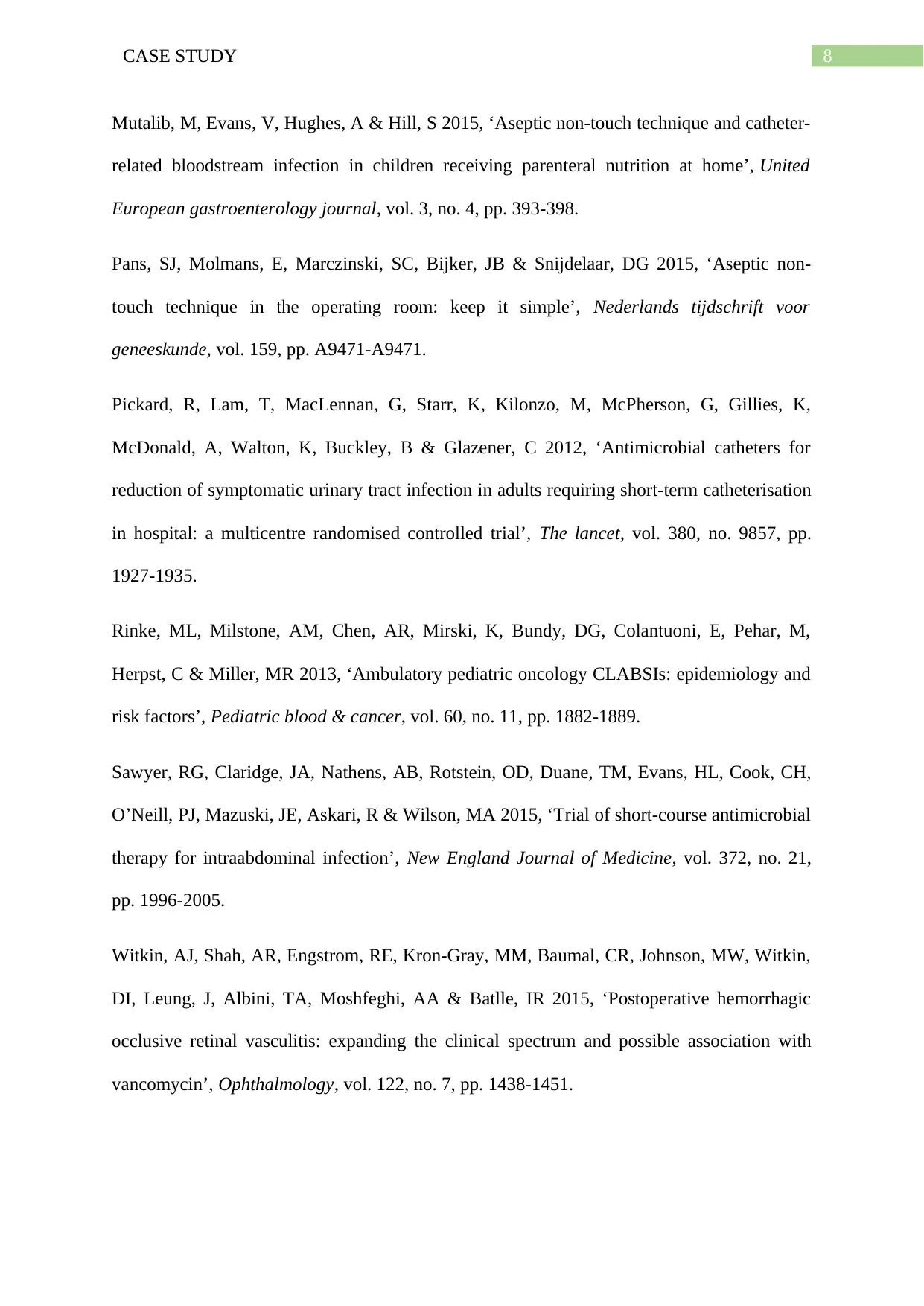
8CASE STUDY
Mutalib, M, Evans, V, Hughes, A & Hill, S 2015, ‘Aseptic non-touch technique and catheter-
related bloodstream infection in children receiving parenteral nutrition at home’, United
European gastroenterology journal, vol. 3, no. 4, pp. 393-398.
Pans, SJ, Molmans, E, Marczinski, SC, Bijker, JB & Snijdelaar, DG 2015, ‘Aseptic non-
touch technique in the operating room: keep it simple’, Nederlands tijdschrift voor
geneeskunde, vol. 159, pp. A9471-A9471.
Pickard, R, Lam, T, MacLennan, G, Starr, K, Kilonzo, M, McPherson, G, Gillies, K,
McDonald, A, Walton, K, Buckley, B & Glazener, C 2012, ‘Antimicrobial catheters for
reduction of symptomatic urinary tract infection in adults requiring short-term catheterisation
in hospital: a multicentre randomised controlled trial’, The lancet, vol. 380, no. 9857, pp.
1927-1935.
Rinke, ML, Milstone, AM, Chen, AR, Mirski, K, Bundy, DG, Colantuoni, E, Pehar, M,
Herpst, C & Miller, MR 2013, ‘Ambulatory pediatric oncology CLABSIs: epidemiology and
risk factors’, Pediatric blood & cancer, vol. 60, no. 11, pp. 1882-1889.
Sawyer, RG, Claridge, JA, Nathens, AB, Rotstein, OD, Duane, TM, Evans, HL, Cook, CH,
O’Neill, PJ, Mazuski, JE, Askari, R & Wilson, MA 2015, ‘Trial of short-course antimicrobial
therapy for intraabdominal infection’, New England Journal of Medicine, vol. 372, no. 21,
pp. 1996-2005.
Witkin, AJ, Shah, AR, Engstrom, RE, Kron-Gray, MM, Baumal, CR, Johnson, MW, Witkin,
DI, Leung, J, Albini, TA, Moshfeghi, AA & Batlle, IR 2015, ‘Postoperative hemorrhagic
occlusive retinal vasculitis: expanding the clinical spectrum and possible association with
vancomycin’, Ophthalmology, vol. 122, no. 7, pp. 1438-1451.
Mutalib, M, Evans, V, Hughes, A & Hill, S 2015, ‘Aseptic non-touch technique and catheter-
related bloodstream infection in children receiving parenteral nutrition at home’, United
European gastroenterology journal, vol. 3, no. 4, pp. 393-398.
Pans, SJ, Molmans, E, Marczinski, SC, Bijker, JB & Snijdelaar, DG 2015, ‘Aseptic non-
touch technique in the operating room: keep it simple’, Nederlands tijdschrift voor
geneeskunde, vol. 159, pp. A9471-A9471.
Pickard, R, Lam, T, MacLennan, G, Starr, K, Kilonzo, M, McPherson, G, Gillies, K,
McDonald, A, Walton, K, Buckley, B & Glazener, C 2012, ‘Antimicrobial catheters for
reduction of symptomatic urinary tract infection in adults requiring short-term catheterisation
in hospital: a multicentre randomised controlled trial’, The lancet, vol. 380, no. 9857, pp.
1927-1935.
Rinke, ML, Milstone, AM, Chen, AR, Mirski, K, Bundy, DG, Colantuoni, E, Pehar, M,
Herpst, C & Miller, MR 2013, ‘Ambulatory pediatric oncology CLABSIs: epidemiology and
risk factors’, Pediatric blood & cancer, vol. 60, no. 11, pp. 1882-1889.
Sawyer, RG, Claridge, JA, Nathens, AB, Rotstein, OD, Duane, TM, Evans, HL, Cook, CH,
O’Neill, PJ, Mazuski, JE, Askari, R & Wilson, MA 2015, ‘Trial of short-course antimicrobial
therapy for intraabdominal infection’, New England Journal of Medicine, vol. 372, no. 21,
pp. 1996-2005.
Witkin, AJ, Shah, AR, Engstrom, RE, Kron-Gray, MM, Baumal, CR, Johnson, MW, Witkin,
DI, Leung, J, Albini, TA, Moshfeghi, AA & Batlle, IR 2015, ‘Postoperative hemorrhagic
occlusive retinal vasculitis: expanding the clinical spectrum and possible association with
vancomycin’, Ophthalmology, vol. 122, no. 7, pp. 1438-1451.
⊘ This is a preview!⊘
Do you want full access?
Subscribe today to unlock all pages.

Trusted by 1+ million students worldwide
1 out of 9
Related Documents
Your All-in-One AI-Powered Toolkit for Academic Success.
+13062052269
info@desklib.com
Available 24*7 on WhatsApp / Email
![[object Object]](/_next/static/media/star-bottom.7253800d.svg)
Unlock your academic potential
Copyright © 2020–2025 A2Z Services. All Rights Reserved. Developed and managed by ZUCOL.





